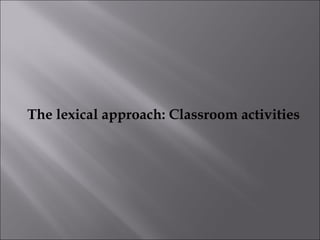
Lexical Approach
- 1. The lexical approach: Classroom activities
- 2. Lexical Approach Classroom Activity General Goals To develop students’ reading skills To increase students’ store of lexical chunks More Specific Goals To motivate students to read by providing texts with universally engaging themes providing activities that allow students to personalize texts encouraging meaningful and authentic initial reactions to texts To raise student awareness of the idea of lexical chunking by directing students’ attention to specific lexical chunks already encountered in the text helping students analyze these chunks directing students to different means of analyzing lexical chunks
- 3. To help students develop skills for independent learning by providing opportunities to experience lexical chunks in authentic texts encouraging students to analyze, generalize, research and experiment with lexical chunks providing students with opportunities to discover chunks for themselves
- 4. TEACHER’S TASK 1 1: Read through this unit of classroom materials as if you were preparing to use them for a group of high intermediate to advanced learners and decide how you would need to adapt the materials. 2: If appropriate adapt and use these materials with your students. After using the materials think about these questions: - Which goals do I think the materials achieved? - Which goals do I think the materials fail to achieve? - Did I notice students doing anything differently with these materials than with other materials I’ve been using? - Did my students have a positive, negative or indifferent response to the materials? - Did I, as a teacher, do anything differently using these materials? - Did I, as a teacher, have a positive, negative or indifferent reaction to these materials?
- 5. School Days – student materials Reading 1 - Away Day Before you read 1: You are going to read a story about a young teenage boy from England. The boy has upset his parents. Read these sentences from the story and decide whether you think they come at the beginning, in the middle or at the end of the story. "I got slapped three times with the sole of her shoe. Three times. That was it. Then she left my room. She never said a word." 2: The story is called Away Day and the first sentence reads, “The only time I ever bunked off school, I was thirteen years old.” What do you think the story is about? Write down some guesses and share them with other students.
- 6. As you read 1: As you read the story from the point of view of a teenage school boy, try to see pictures of the boy in your mind and decide if the boy deserved the punishment.
- 7. After you read Reaction 1: Tell a partner, if you think the boy's punishment was appropriate and what you would have done if you were the parents. 2: Think about the following questions: How do you feel about the boy in the story? Why do you think the boy went with the twins? Why do you think the boy's mother reacted in the way she did? At the beginning of the story the author tells you the twins were always in trouble. Why do you think he tells you that? Discuss your thoughts about the questions in a small group. 3: Discuss your answers to the following questions with a partner: In paragraphs 1 and 2, what words tell you the housing estate is poor/working class? In paragraphs 3 and 4, how do you know the weather is hot and has been hot for some time? In paragraphs 5 and 6 the boy is becoming more and more frightened. What do you think frightens him? The boy was punished in the final paragraph. Was it the punishment he expected? Was the punishment effective?
- 8. Away Day…* Look at the Language 1: Look at the lexical chunks below. All the expressions are from the story, Away Day. For each chunk try to write an equivalent in your language. Are they lexical chunks in your language too? Tell a partner about the lexical chunks in your language. Lexical chunks (frozen or fixed) in the middle of nowhere I had no idea Lexical Chunks (semi-frozen or semi-fixed) She never said a word I didn’t know where we were going I didn’t know what we were doing adjective plus noun partnerships/collocations (words that naturally go together)
- 9. 2: What other nouns can you use after the adjective ‘shiny new’? e.g. shiny new shoes shiny new bike 3: What other nouns can you use after the adjective ‘broken’? e.g. broken heart broken window What nouns can’t you use after ‘broken’? e.g. broken house Examples of verb plus noun collocations (words that naturally go together) I didn’t do my homework. (do / homework) They were always in trouble with the teachers. (be / trouble)
- 10. 4: Underline the weakest verb and noun collocation. Example: Exam take / pass / fail / study for / sit / revise homework do / forget / lose / prepare / finish / hand in trouble be in / expect / make / discover / get into / ask for
- 11. References Lexical Approach Classroom Activities Carlos Islam, The University of Maine Ivor Timmis, Leeds Metropolitan University Available at: http://www.teachingenglish.org.uk/sites/teacheng/files/lexical_try1.pdf
